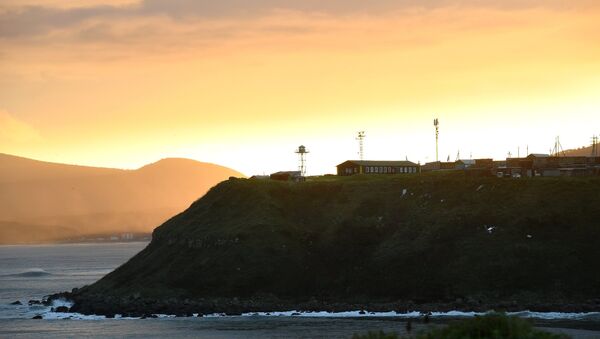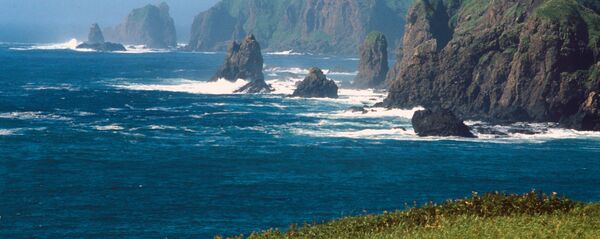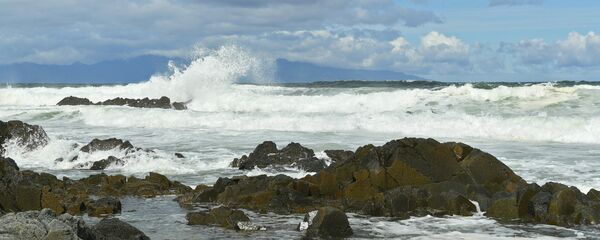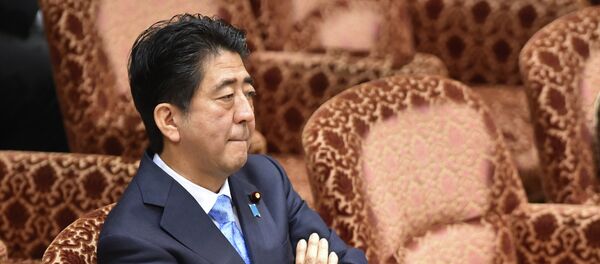Russian President Vladimir Putin and Japanese Prime Minister Shinzo Abe will hold talks in Moscow on 22 January, with a peace deal and the status of the Kuril Islands expected to be high on the agenda. Sputnik has summed up the key facts about the contested Kurils ahead of the much-anticipated meeting.
Islands in Question
Russia and Japan have been in a diplomatic standoff for decades due to disagreements over the sovereignty of four islands; Iturup, Kunashir, Shikotan, and uninhabited Hamobai, referred to as the Southern Kurils by Russia and the Northern Territories by Japan.
Following the defeat of the Japanese in the Second World War, the Soviet Union took back both islands. Under the Potsdam Declaration, signed on 26 July 1945, Japan’s sovereignty was limited to the islands of Honshu, Hokkaido, Kuyshu, Shikoku, and “such minor islands we determine”.
70 Years On and Still No Peace Treaty, Why?
Russia and Japan have been unable to sign a peace treaty since the end of World War II, due to a failure to reach a consensus on the status of the Kuril Islands.
READ MORE: Tokyo's Claims to Kuril Islands Will Complicate Abe's Talks With Putin — Aide
During an international conference in San Francisco in September 1951, the Japanese side signed a controversial peace treaty with 48 Allied Powers, having thus renounced its rights to the Kuril Islands.
The Soviet Union, however, refused to sign the document, reasoning that it did not recognise its sovereignty over South Sakhalin and the Kurils.
What’s the 1956 Joint Declaration About?
In 1956, the Soviet side suggested settling the dispute by returning Shikotan and Habomai to Japan in exchange for a peace treaty. In October, the two sides inked a Joint Declaration to end the state of war that technically existent since August 1945.
READ MORE: Japan Declassifies Historic Docs on Kuril Islands Talks With US
Although Japan refused, demanding the entire chain, Article 9 of the Joint Declaration stipulated that the USSR and Japan “have agreed to continue, after the establishment of normal diplomatic relations between them, negotiations for the conclusion of a peace treaty”.
“Hereby, the USSR, in response to the desires of Japan and taking into consideration the interest of the Japanese state, agrees to hand over to Japan the Habomai and the Shikotan Islands, provided that the actual changing over to Japan of these islands will be carried out after the conclusion of a peace treaty”.
Why Did the Declaration Fail?
The Joint Declaration, however, did not settle the Kuril Islands dispute, with the resolution being delayed until a permanent peace deal could be clinched.
The document contained provisions that granted the US the right to military bases on the archipelago in exchange for a pledge to defend Japan in the event of an attack by a third party.
Following the signing, the Soviet side withdrew its proposal to return the two islets, having sent a memo dated 27 January 1960, saying that those islands would only be handed over to Japan if all foreign troops left its territory.
Back to the 1956 Proposal?
Since Putin and Abe agreed to accelerate negotiations based on the 1956 Soviet proposal in November, there’s been much speculation in the media that Russia will actually return the two islands. The Russian Foreign Ministry has, however, repeatedly stressed that Russia’s sovereignty over the Kuril Islands is “not up for discussion”.
READ MORE: Japan ‘Loses Island’ Near the Disputed Kuril Territory
During a large press conference last week, Russian Foreign Minister Sergei Lavrov emphasised that the demands to hand the Kurils over to Japan are at odds with Tokyo’s obligations under the UN Charter.
“We do not demand anything from Japan. We just call on our Japanese neighbours to bring their practical actions in line with their obligations under the UN Charter, the San Francisco declaration and a number of other documents”, he said, calling on Tokyo to recognise the results of World War II.
In the meantime, Kremlin spokesman Dmitry Peskov has stated that Moscow and Tokyo were trying to reach a compromise.
“Nobody has officially offered anything, so any eventual line of reasoning is hardly appropriate, they don’t help the spirit of the talks. Nobody is going to go against their national interests”.
No US Bases in Japan if Islands Returned?
According to Japanese newspaper Asahi Shimbun, Abe promised in November that there would be no US bases in Japan in the event of the handover of the two islands. In order to meet Russia halfway, Japan’s Foreign Ministry will reportedly hold talks with Washington on its military presence.
The Japanese prime minister is reportedly ready to seal a peace deal if the handover of the Habomai and the Shikotan Islands is guaranteed. According to his administration officials, the return of Iturup and Kunashir seems unrealistic at present.
The Japanese side believes that the negotiations will end up in limbo if Tokyo demands that all four islands be returned at once. According to the news agency Kyodo, Abe remains skeptical of implementing another scenario – the “two islands first” deal with subsequent talks on the return of two others.
New Phase?
In January 2019, Moscow and Tokyo held the first round of talks on the permanent peace deal, with Abe stating that Japan would claim sovereignty over the Kuril Islands. The prime minister said that Tokyo had no intention of deporting Russian citizens living in the archipelago if the islands were surrendered.
READ MORE: Putin, Abe Willing to Sign Peace Treaty — Kremlin Aide
Putin and Abe are expected to hold another round of talks on 22 January, when the Japanese prime minister arrives in Moscow.





